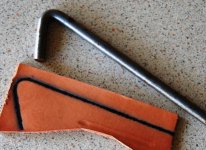There are indeed several different types of leather created by several processes.
The earliest method of curing hides for leather utilized feces and urine. After extended soaking the hide was worked into the intended shape or product, then cured over a smoky fire, with resulted in very durable products capable of serving as armor against arrows and other weapons of the time.
In medieval times towns with tanneries sent out crews with carts to pick up containers of "night soil" from residents, to be used in leather making. Probably the earliest documented "neighborhood recycling" efforts.
In some areas (notably Central and South America and parts of Asia) the use of feces and urine (human or animal) is still common in leather making. A considerable amount of that production is imported to the US and Canada, sometimes reprocessed by chrome-tanning processes for use as upholstery or clothing, but also showing up "as made" in retail hobby shops as a product that mimics many qualities of vegetable-tanned leather and can be used for making holsters, belts, handbags, and other accessories.
Native Americans produced leather by the brain-tanning process, resulting in very soft and durable leather for many purposes. The brain of the animal was processed into a water-based solution, and each animal's brain was said to be sufficient for tanning its own hide. A difficult, labor intensive, time consuming process that is still in limited use, with brain-tanned hides (bison, elk, deer, etc) commanding very high market prices.
Chrome-tanning refers to a process utilizing chemical salts produced from heavy metals, producing a soft and pliable leather suitable for upholstery and clothing applications. Residual chemical salts within the leather can be very corrosive. Some of the first "superfund" EPA clean-up sites were old tanneries, highly polluted with heavy metals.
Vegetable-tanning refers to the process of using emulsions of tannin from plants to cure and stabilize the hides. Many plants contain tannins, such as tea and the bark of shrubs and trees. Perhaps the most common source of tannins is the bark of oak trees, commonly referred to as "oak tanning". The leather produced is capable of being wet-molded to shape, and is very durable in long-term use. "As made" veg-tanned hides are suitable for holsters, belts, shoes, and many other uses. Residual chemical contents are generally not a concern.
The primary source of hides for leather making is from the meat packing industry. Cattle hides are prevalent for this use, with frequent arguments over the relative properties of cow hide, steer (castrated male) hide, bull hide, buffalo hide and so forth, usually revolving around the levels of testosterone within the animal's body during life.
Sheep, ostriches, reptiles, snakes, deer, elk, antelope, elephants, kangaroos, and other creatures can be the source of hides for tanning, with as many potential uses as there are creatures.
Regardless of the source or tanning methods, firearms (and other metal objects) should never be stored in leather holsters or cases for extended times. All leather is hygroscopic in nature, readily absorbing and retaining moisture from the atmosphere, perspiration, and other sources, which can present a potential for corrosion. Some leathers (particularly chrome-tanned leathers) present another potential, as residual chemical salts can go into solution with accumulated moisture and cause serious corrosion from long-term exposure to ferrous metals and firearm finishes.
The best leather holsters are made of vegetable-tanned hides. Even with the best, I recommend removing the firearm after each day of use, wiping the firearm down with an oily rag, and storing the holster separate of the firearm, preferably in an area providing air flow to permit evaporation of any accumulated moisture.
End of tutorial.


